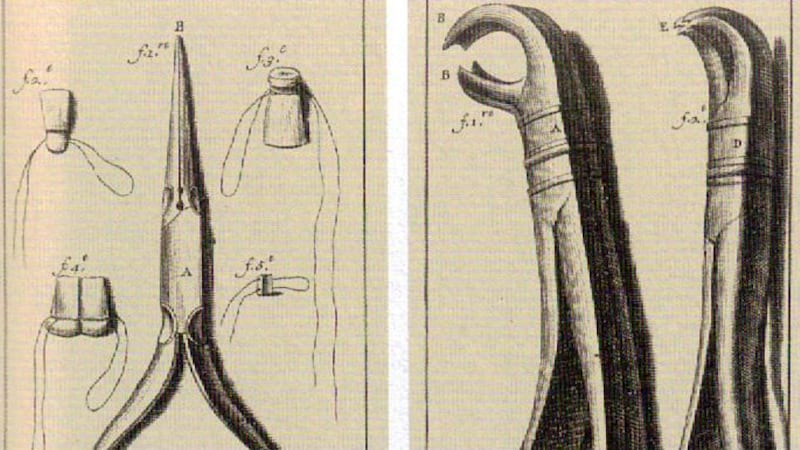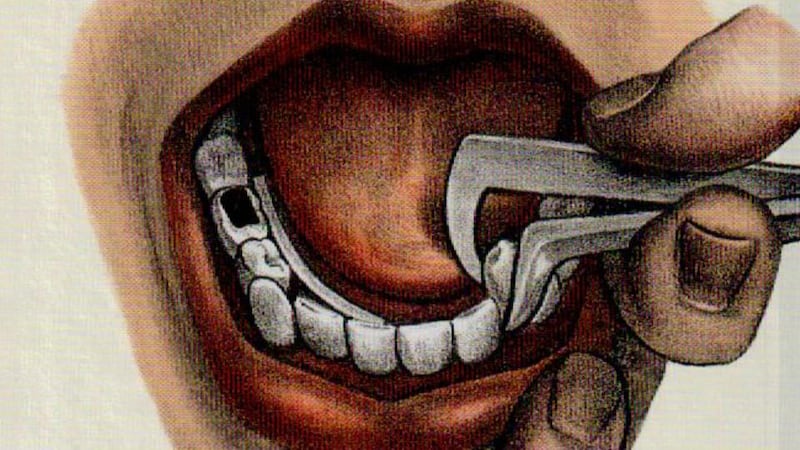Plug was the nickname of an erudite teacher who taught me Latin. Like one of the Bash Street Kids, he was named for the prominence of his front teeth. Did he know this as he scratched in fang-white chalk a third declension noun on the blackboard? Dens, dentis: the Latin word for tooth.
The history of teeth and caring for them is one of pain, butchery and showbiz. Poor people sold their teeth to be implanted in the wealthy. Rusty pliers prised molars from contorted mouths. On a stage-set of agony, charlatans and fakes dominated dentistry until the practice evolved into a profession.
Eighteenth-century Paris crowds roared at Pont Neuf public toothpullings as strong arms yanked out molars in an excruciating spew of blood and spittle. Throughout the ages, howls emanated from rotten gobs. Magical anaesthetic relief arrived with laughing gas, chloroform and cocaine. And the hostile medical profession began to admit dental tradesmen who extracted themselves from blacksmith forges and the hoofing of horses to turn to the tending of human teeth.
All this is vividly portrayed in Richard Barnett's The Smile Stealers, a tale of the trek to modern dentistry and the cultural backdrop from which the profession emerged. As far back as the 19th century, we find the paraphernalia of the practice: "the dental drill, the dental chair, a certificate or licence on the wall and, most of all, the prospect of fillings and extractions without pain". Dental keys and pliers were the basic tools: there is grim amusement in perusing these pages of crude instruments and illustrations of wretches with toothache.
Glowing molar
The unnamed guinea pigs of pain have been spat into history's dental spittoon. Practitioners dominate the landscape. The Paris-based Jean Thomas both entertained and cured by lifting shrieking patients off the ground with an instrument locked on to their rotten tooth, counterlevering their weight to extract the eroded stump. Barnett describes a 1729 engraving: "With his right hand, Thomas grips the boy's head, firmly but kindly, and between the thumb and forefinger of his outstretched left hand he holds a molar which seems to glow faintly against the sky." Thomas was a master surgeon, but his showmanship was frowned on by the emerging professional class of tooth doctors who sought parity with physicians.
Fellow Frenchman Pierre Fauchard was a conduit for this professionalism. He shifted the trade from extraction to tooth preservation and aesthetics. His dentistry was about fillings, about implanting ivory and bone dentures in barren jaws. His delicate implements came from jewelry and watchmaking, and he shunned showmanship for a "light, steady and skillful" hand. Dentistry was no longer just about pain; its practitioners were agents of a consumer capitalism that linked "good teeth, beauty and success". And the clients? Powdered-wigged dandies who understood one thing: "a mouthful of straight, gleaming teeth was a political asset". The poor had to just grin and bear it.
George Washington had just one tooth in his head when inaugurated in 1789. For public appearances, he had painful dentures – of human and elk teeth. Presidential dinners were tricky and, Barnett informs us, the US premier retired to his abode afterwards "to gum his way through platefuls of soft pickled tripe".

Hovering over every white-knuckled adult or child in the dentist chair is the profession’s patron saint, St Apollonaire. Her hagiography has her tormentors break all her teeth before she leaps into the fire at whose stake it was planned she would burn. But relax. You won’t feel a thing.
False teeth gags
The comics and TV of my early childhood were filled with false teeth gags but you don’t hear such jokes anymore. In a world of elective orthodontics, the buck-toothed are phasing themselves out. Near-painless fillings, crowns and extractions have scoured the tannin from our primitive fears. If we don’t fear dentistry so much, we don’t have to laugh at it so often.
Gone are the sit-com set-ups of dental waiting rooms. Gone are the cartoon-strip illustrations of people with a bandage cradling their rotten-toothed jaw. Gone are the references to laughing gas whose crude operation was itself deemed funny. In our white-fang world of confident smiles, false teeth gags have been lost as a genre. But it seems the gurning jokes of Steptoe and Son and 1970s sitcoms may have had their roots in the 1942 Beveridge report and subsequent provision of free dental treatment in Britain. With the founding of the UK's National Health Service in1948, dentists issued two million sets of false teeth in the first year.

False teeth were a simple sociological fact that bit into the post-war popular consciousness. And they provided material for end-of-pier comedians to chew over before they too lay down beside a glass of water containing their set of gnashers. Rather poignantly, Barnett points out that, pre-NHS, “Well into the 1930s, some working-class British women received a full set of dentures as a present for their 21st birthday or their wedding – hardly romantic but cheaper and less painful than a series of extractions over two or three decades.”
Hard-bitten
The primary function of teeth is biting and chewing, ideally on food. A second function is speech: teeth are the furniture around which the rest of the mouth articulates sounds such as dental frictatives. But for many there is a third element: frequent dental trips. Not for me. Until last December, I had not been to the dentist for 10 years. I made an appointment, fearing the worst. But after 30 minutes and a tooth scraping, it was thumbs-up: the tarnished smile of success. I walked home thinking there is no need for the dismal history of dentistry – not when there is the magic of children leaving their baby teeth under pillows; not when I am convinced that teeth can grow back.
The Smile Stealers: The Fine and Foul Art of Dentistry by Richard Barnett (Thames & Hudson)



















